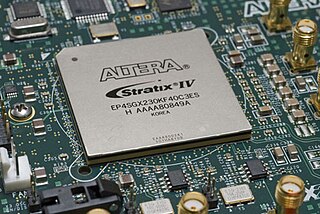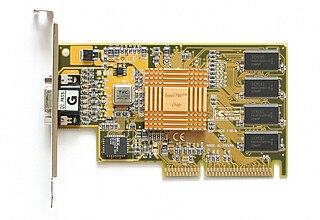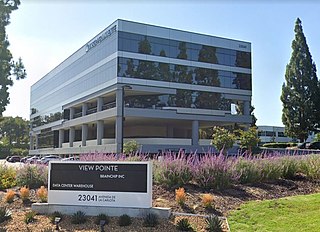Related Research Articles

A field-programmable gate array (FPGA) is a type of configurable integrated circuit that can be repeatedly programmed after manufacturing. FPGAs are a subset of logic devices referred to as programmable logic devices (PLDs). They consist of an array of programmable logic blocks with a connecting grid, that can be configured "in the field" to interconnect with other logic blocks to perform various digital functions. FPGAs are often used in limited (low) quantity production of custom-made products, and in research and development, where the higher cost of individual FPGAs is not as important, and where creating and manufacturing a custom circuit wouldn't be feasible. Other applications for FPGAs include the telecommunications, automotive, aerospace, and industrial sectors, which benefit from their flexibility, high signal processing speed, and parallel processing abilities.

ATI Technologies Inc., commonly called ATI, was a Canadian semiconductor technology corporation based in Markham, Ontario, that specialized in the development of graphics processing units and chipsets. Founded in 1985, the company listed publicly in 1993 and was acquired by AMD in 2006. As a major fabrication-less or fabless semiconductor company, ATI conducted research and development in-house and outsourced the manufacturing and assembly of its products. With the decline and eventual bankruptcy of 3dfx in 2000, ATI and its chief rival Nvidia emerged as the two dominant players in the graphics processors industry, eventually forcing other manufacturers into niche roles.

A graphics processing unit (GPU) is a specialized electronic circuit initially designed to accelerate computer graphics and image processing. After their initial design, GPUs were found to be useful for non-graphic calculations involving embarrassingly parallel problems due to their parallel structure. Other non-graphical uses include the training of neural networks and cryptocurrency mining.
PowerVR is a division of Imagination Technologies that develops hardware and software for 2D and 3D rendering, and for video encoding, decoding, associated image processing and DirectX, OpenGL ES, OpenVG, and OpenCL acceleration. PowerVR also develops AI accelerators called Neural Network Accelerator (NNA).
Proof of work (PoW) is a form of cryptographic proof in which one party proves to others that a certain amount of a specific computational effort has been expended. Verifiers can subsequently confirm this expenditure with minimal effort on their part. The concept was invented by Moni Naor and Cynthia Dwork in 1993 as a way to deter denial-of-service attacks and other service abuses such as spam on a network by requiring some work from a service requester, usually meaning processing time by a computer. The term "proof of work" was first coined and formalized in a 1999 paper by Markus Jakobsson and Ari Juels. The concept was adapted to digital tokens by Hal Finney in 2004 through the idea of "reusable proof of work" using the 160-bit secure hash algorithm 1 (SHA-1).

Hardware acceleration is the use of computer hardware designed to perform specific functions more efficiently when compared to software running on a general-purpose central processing unit (CPU). Any transformation of data that can be calculated in software running on a generic CPU can also be calculated in custom-made hardware, or in some mix of both.

The Intel740, or i740, is a 350 nm graphics processing unit using an AGP interface released by Intel on February 12, 1998. Intel was hoping to use the i740 to popularize the Accelerated Graphics Port, while most graphics vendors were still using PCI. Released to enormous fanfare, the i740 proved to have disappointing real-world performance, and sank from view after only a few months on the market. Some of its technology lived on in the form of Intel Extreme Graphics, and the concept of an Intel produced graphics processor lives on in the form of Intel Graphics Technology and Intel Arc.

Ray-tracing hardware is special-purpose computer hardware designed for accelerating ray tracing calculations.
The transistor count is the number of transistors in an electronic device. It is the most common measure of integrated circuit complexity. The rate at which MOS transistor counts have increased generally follows Moore's law, which observes that transistor count doubles approximately every two years. However, being directly proportional to the area of a die, transistor count does not represent how advanced the corresponding manufacturing technology is. A better indication of this is transistor density which is the ratio of a semiconductor's transistor count to its die area.

Larrabee is the codename for a cancelled GPGPU chip that Intel was developing separately from its current line of integrated graphics accelerators. It is named after either Mount Larrabee or Larrabee State Park in Whatcom County, Washington, near the town of Bellingham. The chip was to be released in 2010 as the core of a consumer 3D graphics card, but these plans were cancelled due to delays and disappointing early performance figures. The project to produce a GPU retail product directly from the Larrabee research project was terminated in May 2010 and its technology was passed on to the Xeon Phi. The Intel MIC multiprocessor architecture announced in 2010 inherited many design elements from the Larrabee project, but does not function as a graphics processing unit; the product is intended as a co-processor for high performance computing.
An AES instruction set is a set of instructions that are specifically designed to perform AES encryption and decryption operations efficiently. These instructions are typically found in modern processors and can greatly accelerate AES operations compared to software implementations. An AES instruction set includes instructions for key expansion, encryption, and decryption using various key sizes.
Canaan Inc., doing business as Canaan Creative and known simply as Canaan, is a China-based computer hardware manufacturer. Established in 2013 by N.G. Zhang, Canaan specializes in Blockchain servers and ASIC microprocessors for use in bitcoin mining.

Tensor Processing Unit (TPU) is an AI accelerator application-specific integrated circuit (ASIC) developed by Google for neural network machine learning, using Google's own TensorFlow software. Google began using TPUs internally in 2015, and in 2018 made them available for third-party use, both as part of its cloud infrastructure and by offering a smaller version of the chip for sale.
Sapphire Rapids is a codename for Intel's server and workstation processors based on the Golden Cove microarchitecture and produced using Intel 7. It features up to 60 cores and an array of accelerators, and it is the first generation of Intel server and workstation processors to use a chiplet design.
Bitmain Technologies Ltd., is a privately owned company headquartered in Beijing, China, that designs application-specific integrated circuit (ASIC) chips for bitcoin mining.
Video Core Next is AMD's brand for its dedicated video encoding and decoding hardware core. It is a family of hardware accelerator designs for encoding and decoding video, and is built into AMD's GPUs and APUs since AMD Raven Ridge, released January 2018.
In semiconductor manufacturing, the "3 nm" process is the next die shrink after the "5 nm" MOSFET technology node. South Korean chipmaker Samsung started shipping its "3 nm" gate all around (GAA) process, named "3GAA", in mid-2022. On 29 December 2022, Taiwanese chip manufacturer TSMC announced that volume production using its "3 nm" semiconductor node ("N3") was under way with good yields. An enhanced "3 nm" chip process called "N3E" may have started production in 2023. American manufacturer Intel planned to start 3 nm production in 2023.
Cryptojacking is the act of exploiting a computer to mine cryptocurrencies, often through websites, against the user's will or while the user is unaware. One notable piece of software used for cryptojacking was Coinhive, which was used in over two-thirds of cryptojacks before its March 2019 shutdown. The cryptocurrencies mined the most often are privacy coins—coins with hidden transaction histories—such as Monero and Zcash.

BrainChip is an Australia-based technology company, founded in 2004 by Peter Van Der Made, that specializes in developing advanced artificial intelligence (AI) and machine learning (ML) hardware. The company's primary products are the MetaTF development environment, which allows the training and deployment of spiking neural networks (SNN), and the AKD1000 neuromorphic processor, a hardware implementation of their spiking neural network system. BrainChip's technology is based on a neuromorphic computing architecture, which attempts to mimic the way the human brain works. The company is a part of Intel Foundry Services and Arm AI partnership.
References
- ↑ Tyson, Mark (2022-06-30). "Intel's Blockscale Cryptominer Ships Ahead of Schedule, Late to the Party". Tom's Hardware. Retrieved 2023-04-19.
- ↑ Mann, Tobias (19 April 2023). "Intel axes Blockscale cryptomining ASICs it debuted in 2022". www.theregister.com. Retrieved 2023-04-19.
- 1 2 Alcorn, Paul (2023-04-18). "Intel Discontinues Bitcoin-Mining Blockscale Chips, No Future Gens Announced". Tom's Hardware. Retrieved 2023-04-19.
- ↑ Cunningham, Andrew (2023-04-18). "Intel unceremoniously dumps its year-old Blockscale chips for bitcoin mining". Ars Technica. Retrieved 2023-04-19.
- ↑ "Intel® Blockscale™ ASIC". intel.com. Archived from the original on 2023-03-27. Retrieved 2023-03-27.